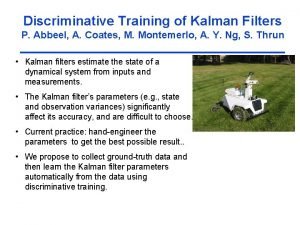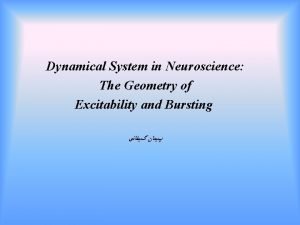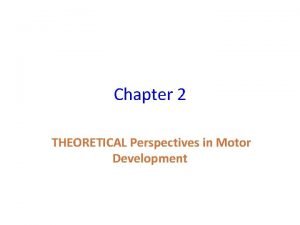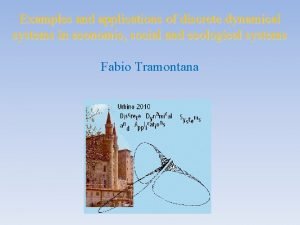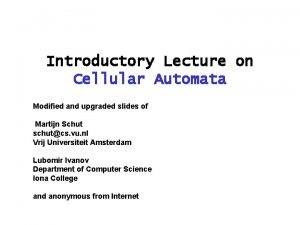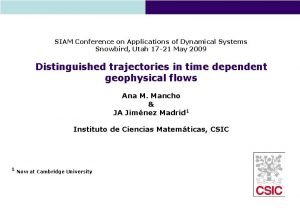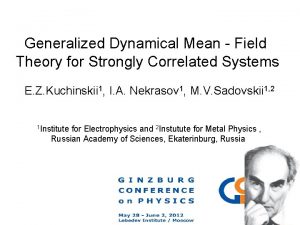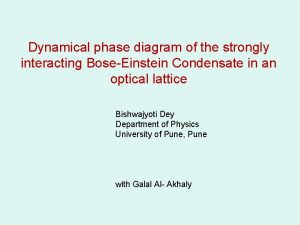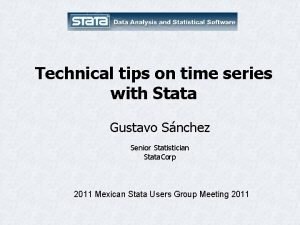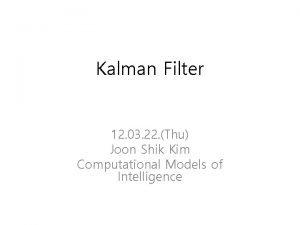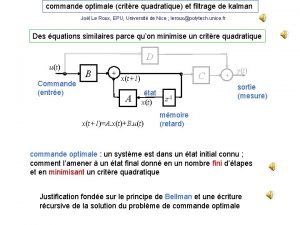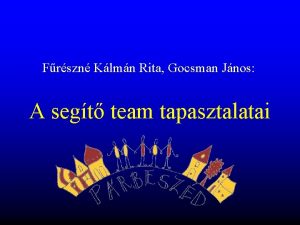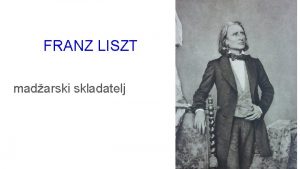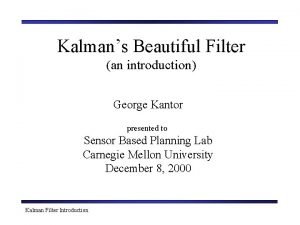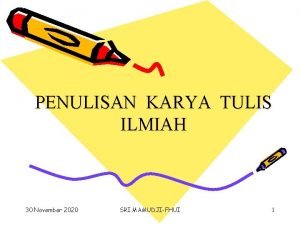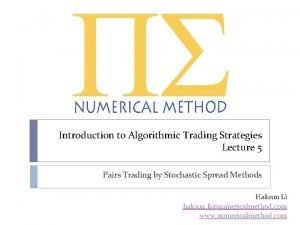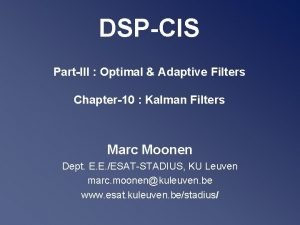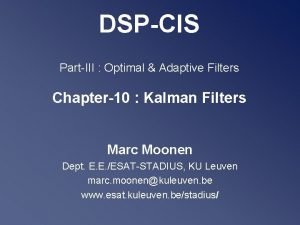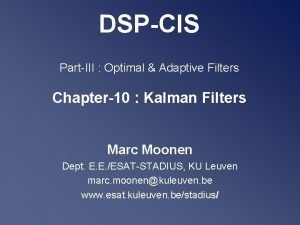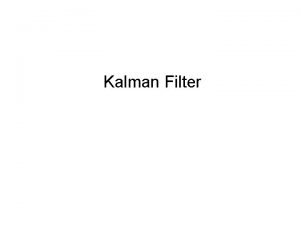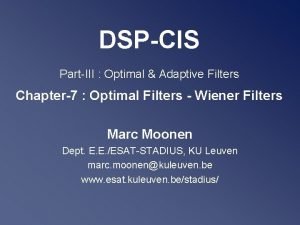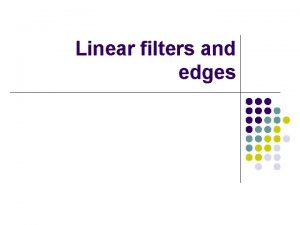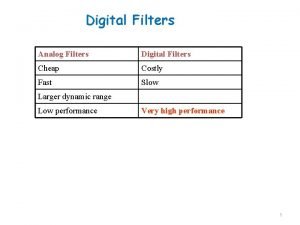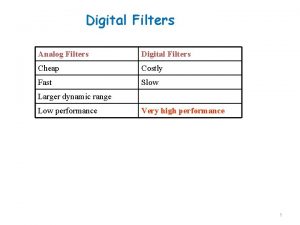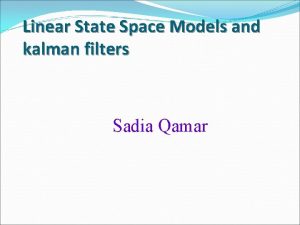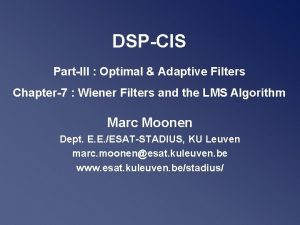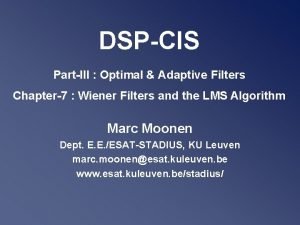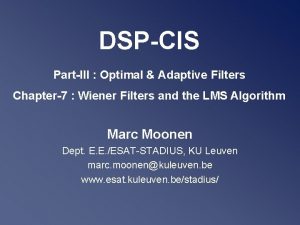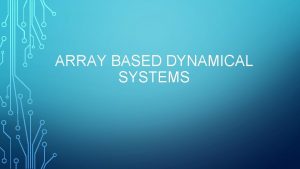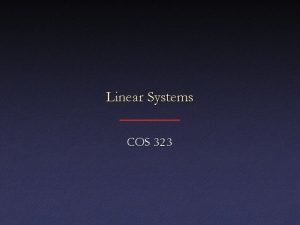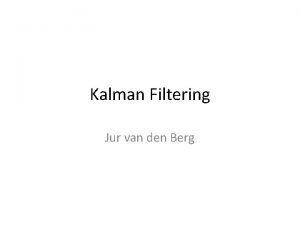Kalman Filters and Linear Dynamical Systems and Optimal





















- Slides: 21

Kalman Filters and Linear Dynamical Systems and Optimal Adaptation To A Changing Body (Koerding, Tenenbaum, Shadmehr)

Tracking ü ü {Cars, people} in {video images, GPS} Observations via sensors are noisy Recover true position Temporal task Position at t is determined in part by position at t-1 face tracking demo ü ü object tracking demo multiple person tracking demo (offline demo) Coifman et al.

Bayesian Formulation ü Prior Predicted position of object based on previous position and velocity ü Likelihood Noisy observation ü Posterior Bayesian update

Graphical Model Formulation With Time ü ü ü X 1 X 2 X 3 Z 1 Z 2 Z 3 Xt: state (position, velocity) at time t Zt: observation (image, GPS data) at time t P(Xt|Xt-1): state dynamics (how vehicle/person moves) P(Zt|Xt): observation dynamics (how observations are generated)

HMM Versus State Space Model ü HMM X is discrete; Z is often discrete Transition distribution is look up table ü State-space model X 1 X 2 X 3 Z 1 Z 2 Z 3 X and Z are continuous vectors Dynamics (Xt→Xt+1, Xt→Zt) are arbitrary ü Linear state-space model State-space model with linear dynamics ü Kalman filter Linear state-space model with additive Gaussian noise

Kalman Filter Generative Model ü ü Dynamics: linear stochastic difference equation Observation model U 1 U 2 U 3 X 1 X 2 X 3 Z 1 Z 2 Z 3 Noise distributions What distributions do x and z have?

Kalman Filter § Assumes known dynamics and observation model, but that can be learned as well Offline: EM algorithm On-line: Gradient ascent in log likelihood § Uses Prediction Smoothing (noise reduction) Uncertainty estimation § Optimal: minimizes estimation error Credit: Hal Daumé III

Kalman Filter Inference Mean of predicted Xk given all observations to k-1 Reliability of observation vs. internal prediction U 1 U 2 U 3 X 1 X 2 X 3 Z 1 Z 2 Z 3 Mean of predicted Xk-1 given all observations to k-1

Extensions ü Nonlinear dynamics Extended Kalman filter Particle filter ü Switched linear dynamics E. g. , running vs. walking vs. climbing S 1 S 2 S 3 X 1 X 2 X 3 Z 1 Z 2 Z 3

Motor Adaptation ü Thought experiment Walking on the moon ü Many reasons for changing response of muscles § Fatigue § Disease § Exercise § Development

Simple Example ü ü ü Saccadic eye movement to target Adaptation task Motor error -> gain adjustment error

Time Scale ü When muscles are perturbed, what is the time scale of the perturbation? § Fatigue: a few minutes § Disease/injury: months § Exercise: months to years § Development: lifetime ü ü Any adaptation to perturbation should last only as long as the time scale of the perturbation. Key idea Need to represent perturbations at multiple time scales ü Terminology Perturbation = Disturbance = Deviation of gain from default (1. 0)

Generative Model of Disturbances: Random Walk At Two Time Scales

Kalman Filter Model Of Adaptation ü ü ü X: vector of internal gain disturbances, one per time scale Z: net gain disturbance X 1 X 2 X 3 Z 1 Z 2 Z 3 τ : something like number of time steps for state to decay § τ=1 (fast time scale) vs. τ=100 (slow time scale) § Large τ -> less memory of past, more noise -> rapid increase in uncertainty over time

Credit Assignment ü Net observed disturbance is sum of slow and fast After prolonged exposure to disturbance: shift from fast to slow scale ü Why is there a tendency to move ↑ instead of →?

Saccadic Gain Adaptation Two phases of gain Adaptation (30% shift) Maintained perturbation leads to slow shift from fast time scale to slow time scale Note that final state is not the same as initial state, even though behavior is identical.

Phase 1 Phase 2 Multiday study: 1500 trials per day, followed by dark goggles. Features: (1) Day-to-day forgetting; (2) faster relearning Model claim: Forgetting occurs because monkey makes eye movements without feedback → greater uncertainty over time

Double Reversal Experiment Tgt jump: +35% -35% +35% Slow states positive; fast states negative

Double Reversal Experiment II No intrasaccadic target steps During dark period, decay of to zero at all time scales. Faster decay for faster time scales. Because slow time scales are positive, net increase in gain Increased uncertainty -> rapid learning

Relation To Human Memory ü Effect of relearning Faster to relearn material than initial acquisition ü Effect of spacing Material is better remembered if the time between study sessions is increased

Relevance To AI / Machine Learning ü Robotics § Any agent dealing with complex, nonstationary environment needs to adapt continuously § But also needs to remember what had been learned earlier ü HCI § If you’re going to design a system that adapts to users, it must have memory of user at multiple time scales
 Discriminative training of kalman filters
Discriminative training of kalman filters Dynamical systems neuroscience
Dynamical systems neuroscience Motor development theories
Motor development theories Accelarationist
Accelarationist Automata
Automata Siam conference on applications of dynamical systems
Siam conference on applications of dynamical systems Difference between linear and nonlinear spatial filters
Difference between linear and nonlinear spatial filters Barycentric dynamical time
Barycentric dynamical time Dynamical mean-field theory
Dynamical mean-field theory Dynamical
Dynamical Kalman filter computer vision
Kalman filter computer vision Scalar kalman filter
Scalar kalman filter Stata kalman filter
Stata kalman filter Kalman filter apollo
Kalman filter apollo Critère de kalman
Critère de kalman Michal kalman vek
Michal kalman vek Kálmán rita pszichológus
Kálmán rita pszichológus Vražji goslač paganini
Vražji goslač paganini Tanja kalman šipoš
Tanja kalman šipoš Kalman filter introduction
Kalman filter introduction Kalman
Kalman Introduction to algorithmic trading strategies
Introduction to algorithmic trading strategies
